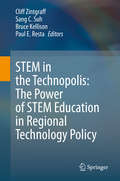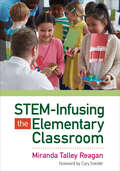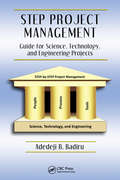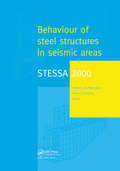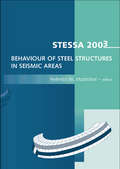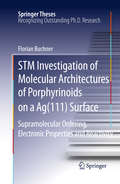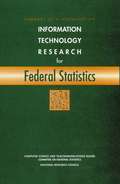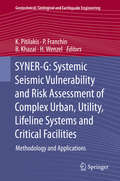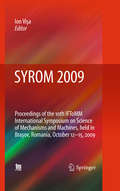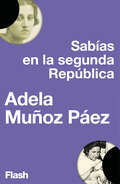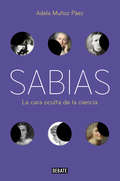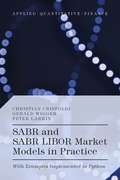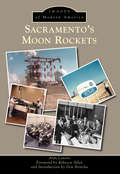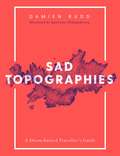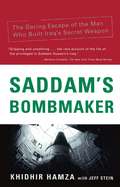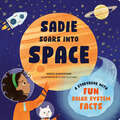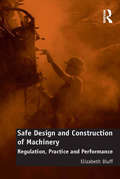- Table View
- List View
STEM for All: How to Connect, Create, and Cultivate STEM Education for All Learners
by Leena Bakshi McLeanHelp close the STEM gap through theory and practical tools Containing all of the practical tools needed to put theory into practice, STEM for All by Leena Bakshi McLean provides a roadmap for teachers, instructional coaches, and leaders to better understand the challenges that create low engagement and scores in STEM subjects and implement exciting and culturally relevant teaching plans. This book covers a wealth of key topics surrounding the subject, including classroom culture, discourse, identity, and belonging, family and community participation, and justice-centered core learning. This book uses the Connect, Create, and Cultivate framework from STEM4Real, an organization that provides socially just and culturally relevant STEM teaching and standards-based learning strategies, combined with stories and case studies of real students throughout to provide context for key concepts. In this book, readers will learn about: Six pillars that can throw off the foundation of a classroom, including non-inclusive curriculum and lack of equal access Moments of triumph and resilience that can be used to navigate rocky and recalcitrant relationships Implicit and unconscious biases that can unravel our impact despite our best intentions STEM for All earns a well-deserved spot on the bookshelves of all educators motivated to close the STEM gap and better prepare their students for future college and career opportunities in math and science fields.
STEM in the Technopolis: The Power of STEM Education in Regional Technology Policy
by Sang C. Suh Cliff Zintgraff Bruce Kellison Paul E. RestaThis book addresses how forward-thinking local communities are integrating pre-college STEM education, STEM pedagogy, industry clusters, college programs, and local, state and national policies to improve educational experiences, drive local development, gain competitive advantage for the communities, and lead students to rewarding careers. This book consists of three sections: foundational principles, city/regional case studies from across the globe, and state and national context. The authors explore the hypothesis that when pre-college STEM education is integrated with city and regional development, regions can drive a virtuous cycle of education, economic development, and quality of life.Why should pre-college STEM education be included in regional technology policy? When local leaders talk about regional policy, they usually talk about how government, universities and industry should work together. This relationship is important, but what about the hundreds of millions of pre-college students, taught by tens of millions of teachers, supported by hundreds of thousands of volunteers, who deliver STEM education around the world? Leaders in the communities featured in STEM in the Technopolis have recognized the need to prepare students at an early age, and the power of real-world connections in the process. The authors advocate for this approach to be expanded. They describe how STEM pedagogy, priority industry clusters, cross-sector collaboration, and the local incarnations of global development challenges can be made to work together for the good of all citizens in local communities. This book will be of interest to government policymakers, school administrators, industry executives, and non-profit executives. The book will be useful as a reference to teachers, professors, industry professional volunteers, non-profit staff, and program leaders who are developing, running, or teaching in STEM programs or working to improve quality of life in their communities.
STEM-Infusing the Elementary Classroom
by Miranda Talley ReaganMake learning relevant with STEM essential questions This engaging, teacher-friendly guide helps teachers quickly and confidently infuse STEM concepts into all content areas. Real-world vignettes, sample lesson templates, discussion questions and immediately applicable action steps help you seamlessly promote college and career ready skills. Use this inspiring guide to: Deepen all content areas, including English/ Language Arts Promote the 4Cs: communication, collaboration, critical thinking, and creativity Require students to take risks to solve problems Differentiate instruction and scaffold support Expand students’ specific measurable capabilities Incorporate design skills into the curricula Save valuable time and confidently develop standards-aligned STEM projects in all content areas!
STEM-Infusing the Elementary Classroom
by Miranda Talley ReaganMake learning relevant with STEM essential questions This engaging, teacher-friendly guide helps teachers quickly and confidently infuse STEM concepts into all content areas. Real-world vignettes, sample lesson templates, discussion questions and immediately applicable action steps help you seamlessly promote college and career ready skills. Use this inspiring guide to: Deepen all content areas, including English/ Language Arts Promote the 4Cs: communication, collaboration, critical thinking, and creativity Require students to take risks to solve problems Differentiate instruction and scaffold support Expand students’ specific measurable capabilities Incorporate design skills into the curricula Save valuable time and confidently develop standards-aligned STEM projects in all content areas!
STEP Project Management: Guide for Science, Technology, and Engineering Projects (Systems Innovation Book Series)
by Adedeji B. BadiruWhile the project management body of knowledge is embraced by disciplines ranging from manufacturing and business to social services and healthcare, the application of efficient project management is of particularly high value in science, technology, and engineering undertakings. STEP Project Management: Guide for Science, Technology, and Engineeri
STESSA 2000: Proceedings of the Third International Conference STESSA 2000, Montreal, Canada, 21-24 August 2000
by Federico M. Mazzolani; Robert TremblayThis is a review of developments in the behaviour and design of steel structures in seismic areas. The proceedings look at the analytical and experimental research on the seismic response of steel structures, and cover topics such as global behaviour and codification, design and application.
STESSA 2003 - Behaviour of Steel Structures in Seismic Areas: Proceedings of the 4th International Specialty Conference, Naples, Italy, 9-12 June 2003
by Federico M. MazzolaniPresenting a comprehensive overview of recent developments in the field of seismic resistant steel structures, this volume reports upon the latest progress in theoretical and experimental research into the area, and groups findings in the following key sections:· performance-based design of structures· structural integrity under exceptional loading· material and member behaviour· connections· global behaviour· moment resisting frames· passive and active control· strengthening and repairing· codification· design and application
STM Investigation of Molecular Architectures of Porphyrinoids on a Ag(111) Surface
by Florian BuchnerThe self-assembly of large organic molecules has become a vividly explored and interdisciplinary field in science. One major goal is the tailored fabrication of highly ordered, molecular networks, which are stabilized on a metal surface. Metalloporphyrins receive particular attention, because their distinct intrinsic functionalities make them promising candidates for applications in chemical sensors, solar cells, and for tailored catalytic processes. Based on scanning tunneling microscopy investigations, several novel and fundamental contributions are presented, which has led to a new level of understanding. Highlights are the results with respect to intramolecular conformation and supramolecular ordering, electronic interactions with the substrate, surface confined synthesis such as in-situ metallation reactions, and ligand effects.The number of publications this work has led to emphasises its quality and significance.
SUMMARY OF A WORKSHOP ON INFORMATION TECHNOLOGY RESEARCH for Federal Statistics
by National Research Council Committee on National Statistics Compature Science Telecommunications BoardSUMMARY OF A WORKSHOP ON INFORMATION TECHNOLOGY RESEARCH for Federal Statistics
SWORDS INTO MARKET SHARES: Technology, Economics, and Security in the New Russia
by Glenn E. SchweitzerWhile researching this book, Glenn Schweitzer met four Moscow physicists who were trying to license Russian technology to western firms for product manufacture. During the worst times, they were reduced to driving taxis to keep things afloat. He asked them, will technological innovation have a discernible impact on the Russian economy in the coming decade? No, was the immediate reply. Are they right?In Swords into Market Shares, Schweitzer examines the roots of such pessimism and the prospects for Russia to prosper from its technology in the post-Soviet world. He explores the different visions of prosperity held by entrepreneurs, technologists, and government officials and goes on to examine the barriers to progress as Russia struggles to build a viable technology industry on its own terms. In accessible language, this book talks about technology's place within Russia's economy and its research and development infrastructure. Schweitzer looks at the impact of the Soviet legacy--central planning, lack of priorities, scant incentives for personal initiative--and the aftermath of the Russian financial meltdown of 1998.He also reviews the experiences of American companies that have invested in Russian technology and examines the results of pressure to reform according to the economic model of the West. Schweitzer goes on to document the problems of economic crime and government corruption, which plague activities designed to generate income in Russia. He discusses the lack of protection for intellectual property and taxation issues that stand in the way of technological innovation. The book looks at the impact of the "brain drain" as Russian experts seek greener pastures--not only the ominous recruitment of Russian biological weapons experts and the acquisition of military technology by "rogue" nations--but also Russia's own program to sell military technology for badly needed funds.Schweitzer's use of case studies and examples puts a human face on these issues. He also discusses Russia's 60 "science cities"--sites of state research centers--with close-ups of three "nuclear cities."Can the technical strengths of the Soviet military complex find a place in civilian Russia? How can this vast country sustain even a minimal standard of living? Swords into Market Shares addresses these and other key questions and explores fundamental policy issues confronting both Russia and the United States as Russia struggles for an economic foothold.
SYNER-G: Systemic Seismic Vulnerability and Risk Assessment of Complex Urban, Utility, Lifeline Systems and Critical Facilities
by K. Pitilakis P. Franchin B. Khazai H. WenzelSYNER-G, a multidisciplinary effort funded by the European Union, allowed the development of an innovative methodological framework for the assessment of physical as well as socio-economic seismic vulnerability and risk at urban and regional level. The results of SYNER-G are presented in two books both published by Springer, the present and a second one, entitled "SYNER-G: Typology Definition and Fragility Functions for Physical Elements at Seismic Risk: Buildings, Lifelines, Transportation Networks and Critical Facilities"(*), which provides a comprehensive state-of-the-art of the fragility curves, an alternative way to express physical vulnerability of elements at risk. In this second volume of SYNER-G, the focus has been on presenting a unified holistic methodology for assessing vulnerability at systems level considering interactions between elements at risk (physical and non-physical) and between different systems. The proposed methodology and tool encompasses in an integrated fashion all aspects in the chain, from hazard to the vulnerability assessment of components and systems and to the socio-economic impacts of an earthquake, accounting for most relevant uncertainties within an efficient quantitative simulation scheme. It systematically integrates the most advanced fragility functions to assess the vulnerability of physical assets for buildings, utility systems, transportation networks and complex infrastructures such as harbours and hospitals. The increasing impact due to interactions between different components and systems is treated in a comprehensive way, providing specifications for each network and infrastructure. The proposed socio-economic model integrates social vulnerability into the physical systems modelling approaches providing to decision makers with a dynamic platform to capture post disaster emergency issues like shelter demand and health impact decisions Application examples at city and regional scale have provided the necessary validation of the methodology and are also included in the book. The present volume, with its companion volume on fragility functions, represent a significant step forward in the seismic vulnerability and risk assessment of complex interacting urban and regional systems and infrastructures. These volumes are not only of interest to scientists and engineers but also to the insurance industry, decision makers and practitioners in the sector of civil protection and seismic risk management. (*) Pitilakis K, Crowley E, Kaynia A (eds) (2014) SYNER-G: Typology definition and fragility functions for physical elements at seismic risk, Series: Geotechnical, Geological and Earthquake Engineering 27, ISBN 978-94-007-7872-6, Springer Science+Business Media, Dordrecht.
SYROM 2009
by Ion VisaSYROM conferences have been organized since 1973 by the Romanian branch of the International Federation for the Promotion of Mechanisms and Machine Science IFToMM, Year by year the event grew in quality. Now in its 10th edition, international visibility and recognition among the researchers active in the mechanisms science field has been achieved. SYROM 2009 brought together researchers and academic staff from the field of mechanisms and machine science from all over the world and served as a forum for presenting the achievements and most recent results in research and education. Topics treated include conceptual design, kinematics and dynamics, modeling and simulation, synthesis and optimization, command and control, current trends in education in this field, applications in high-tech products. The papers presented at this conference were subjected to a peer-review process to ensure the quality of the paper, the engineering significance, the soundness of results and the originality of the paper. The accepted papers fulfill these criteria and make the proceedings unique among the publications of this type.
Sabias en la Segunda República (Flash Ensayo)
by Adela Muñoz PáezUn breve recorrido por la historia de la ciencia española y sus primeras grandes científicas. ¿Qué papel desempeñaron las mujeres durante la Edad de Plata que la ciencia vivió en la Segunda República española? Adela Muñoz Páez rescata la historia de algunas de las mujeres españolas que han hecho contribuciones relevantes a la ciencia y paralelamente, para entender por qué fueron tan escasas y hoy son tan desconocidas, realiza un paseo por la España de comienzos del siglo XX hasta nuestros días. Así, descubriremos que el movimiento feminista español gestado a finales del siglo XIX dio sus frutos más brillantes durante la Segunda República; que debido a la guerra una generación entera de científicas cayó en el olvido y que durante el franquismo no solo se anularon todos los logros conseguidos en cuestiones de igualdad, sino que se desprestigió a las mujeres y los hombres que los protagonizaron y se borraron sus huellas de los anales de la ciencia. Hoy su redescubrimiento es un ejercicio de justicia histórica para que por fin brillen con todo su esplendor.
Sabias: La otra cara de la ciencia
by Adela Muñoz PáezUn fascinante recorrido por la historia de las mujeres de la ciencia. ¿Quién fue Enheduanna? ¿Y Émilie de Châtelet? ¿Por qué los maestros cerveceros consideran su mentora a Hildegarda de Bingen, una monja del siglo XI? ¿Fue Marie Curie merecedora de los dos premios Nobel de ciencias que recibió? ¿Habría sido posible descifrar la estructura del ADN sin el trabajo de Rosalind Franklin? ¿Por qué es tan desconocida la mujer que desentrañó la estructura de la penicilina? ¿Qué papel tuvieron las mujeres durante la Edad de Plata que la ciencia vivió en la Segunda República española? En este libro rescatamos la historia de algunas de las mujeres que han hecho contribuciones relevantes en la ciencia y paralelamente, para entender porqué fueron tan escasas y hoy son tan desconocidas, realizamos un recorrido por la historia. En este paseo descubrimos que hasta bien entrado el siglo XX, las mujerestuvieron vetado el ingreso en las universidades y el ejercicio de muchas profesiones que requerían estudios, y que antes habían sido expulsadas de las bibliotecas de los monasterios, los centros donde se refugió el saber durante la Edad Media. También descubrimos que sus historias fueron borradas de los anales de la ciencia o sus contribuciones les fueron arrebatadas. Las mujeres científicas de la historia están siendo hoy redescubiertas para pasmo y solaz de propios y extraños, y brillan con todo su esplendor.
Sabkha Ecosystems
by Münir Öztürk Benno Böer Hans-Jörg Barth Siegmar-W. Breckle M. Ajmal Khan Miguel Clüsener-GodtThis book is part of the Sabkha Ecosystems series. The series is designed to provide information on sabkha ecosystems of different regions. It will add to the collective knowledge available about saline ecosystems and also focuses on the African region where only limited information is currently available on.
Sabkha Ecosystems: Volume VI: Asia/Pacific (Tasks for Vegetation Science #49)
by Benno Böer M. Ajmal Khan Miguel Clüsener-Godt Bilquees Gul Abdul HameedThis book is the sixth and final volume in the Tasks for Vegetation Science book series, and it concludes the most comprehensive scientific documentation dealing with hypersaline ecosystems of the world.
Sabotage
by Matt CookA cruise ship loses power in the North Atlantic. A satellite launches in the South Pacific. Professor Malcolm Clare—celebrated aviator, entrepreneur, and aerospace engineer—disappears from Stanford University and wakes up aboard an unknown jet, minutes before the aircraft plunges into the high seas. An extortionist code-named "Viking" has seized control of a private warfare technology, pitting a U.S. defense corporation against terrorist conspirators in a bidding war. His leverage: a threat to destroy the luxury liner and its 3,000 passengers. Stanford doctoral student Austin Hardy, probing the disappearance of his professor, seeks out Malcolm Clare's daughter Victoria, an icy brunette with a secret that sweeps them to Saint Petersburg. Helped by a team of graduates on campus, they must devise Trojan horses, outfox an assassin, escape murder in Bruges, and sidestep treachery in order to unravel Viking's scheme. Failure would ensure economic armageddon in the United States.Both on U.S. soil and thousands of miles away, the story roars into action at supersonic speed. Filled with an enigmatic cast of characters, Sabotage, Matt Cook's debut novel, is a sure thrill ride for those who love the puzzles of technology, cryptology, and people. At the Publisher's request, this title is being sold without Digital Rights Management Software (DRM) applied.
Sabr and Sabr LIBOR Market Models in Practice: With Examples Implemented in Python (Applied Quantitative Finance)
by Peter Larkin Christian Crispoldi GéraldwiggerSabr and Sabr LIBOR Market Models in Practice.
Sachem Head's Activism at Autodesk
by Suraj Srinivasan Quinn PitcherIn 2015, activist hedge fund Sachem Head Capital, led by founder Scott Ferguson, launched an activist campaign at (computer aided design) CAD software maker Autodesk. The activist campaign, waged mainly in private, was over Autodesk's lacklustre financial performance, with Ferguson thinking that Autodesk's performance could improve with better cost management. Facing a proxy contest, Autodesk added Ferguson and two others to its board in exchange for a standstill agreement. Following two years of significantly improved performance, Ferguson eventually stepped down when longtime Autodesk CEO Carl Bass announced his retirement in February 2017. The case illustrates how even companies with stellar products can underperform and how benchmarking and financial analysis can help identify drivers of firm performance. The case describes how boards and investors can engage to improve governance and ultimately achieve sustainable performance objectives.
Sacramento’s Moon Rockets (Images of Modern America)
by Don Brincka Alan Lawrie Rebecca AllenOn July 16, 1969, a Saturn V rocket launched the Apollo spacecraft carrying American astronauts to the surface of the moon, where Neil Armstrong would take his famous first steps and fulfill Pres. John F. Kennedy's goal of a successful lunar landing by the end of the decade. This event marks one of the greatest achievements in human history and is in large part due to the years of rocket testing that took place at the Douglas Aircraft Company's Sacramento testing facility (SACTO). The SACTO facility played one of the most important roles in the success of the Apollo 11 lunar mission and is where the Saturn rocket's S-IVB stage was developed and tested--making this historic accomplishment possible.
Sad Topographies
by Damien RuddSad Topographies is an illustrated guide for the melancholic among us. Dispirited travellers rejoice as Damien Rudd journeys across continents in search of the world’s most joyless place names and their fascinating etymologies. Behind each lugubrious place name exists a story, a richly interwoven narrative of mythology, history, landscape, misadventure and tragedy. From Disappointment Island in the Southern Ocean to Misery in Germany, across to Lonely Island in Russia, or, if you’re feeling more intrepid, pay a visit to Mount Hopeless in Australia – all from the comfort of your armchair. With hand drawn maps by illustrator Kateryna Didyk, Sad Topographies will steer you along paths that lead to strange and obscure places, navigating the terrains of historical fact and imaginative fiction. At turns poetic and dark-humoured, this is a travel guide quite like no other. Damien Rudd is the founder of the hugely popular Instagram account @sadtopographies.
Saddam's Bombmaker
by Khidhir Hamza Jeff SteinThe Iraqi scientist who designed Baghdad's nuclear bomb tells how he did it in secret with the cynical help of U.S., French, German, and British suppliers and experts, and kept it hidden from U.N. inspectors after the Gulf War. Today, he says, Saddam Hussein is only months away from making a workable bomb and has every intention of using it. Don't tell me about the law. The law is anything I write on a scrap of paper." Saddam Hussein In 1994, after twenty years developing Iraq's atomic weapon, Dr. Khidhir Hamza made a daring escape to warn the CIA of Saddam's nuclear ambitions...only to be ridiculed and turned away! After a harrowing journey across three continents with Iraqi agents on his trail, Hamza finally came in from the cold at the U.S. embassy in Hungary. Now he tells a frightening story that U.S. officials have finally come to believe: that Saddam is still feverishly at work on the bomb and, if pushed to the wall, will use it. Dr. Hamza also presents a startling, unprecedented portrait of Saddam himself his drunken rages, his women, his fear of germs, and his cold-blooded murder of underlings. A former resident of the presidential palace, Hamza is the only defector who has lived to write a firsthand, intimate portrait of the Iraqi inner circle, its spies and hit men, and their brutal chief. Saddam's Bombmaker is also a saga of one man's journey through the circles of hell. Educated at MIT and Florida State University, dedicated to a life of peaceful teaching in America, Dr. Hamza relates how the regime ordered him home, seduced him into a pampered life as an atomic energy official, and forced him to design a bomb. The price of refusal was torture. As the father of the Iraqi bomb, Dr. Hamza designed a device from scratch with the help of World War Twoera blueprints from America's Los Alamos labs, all the while planning an escape. Privately, he and his colleagues believed they could procrastinate long enough to outlive Saddam. But the dictator outmaneuvered them, whipping the scientists into a crash program to build a crude bomb that could be dropped on Israel. Had U.S. and Allied forces not quickly mobilized for Desert Storm, Dr. Hamza relates, Saddam may well have succeeded; except for sufficient uranium, the device was ready. It still is. Dr. Hamza's tale of his escape, his first bungled contact with CIA agents, and his flight abroad will keep readers turning pages toward a climax worthy of a well-crafted spy thriller. Along the way, he reveals: The West's "don't ask, just sell" attitude toward Iraq's nuclear, chemical, and biological programs as long as it was fighting Iran. How Iraq tested biological and chemical weapons on human subjects. How the Palestinian Liberation Organization (PLO) tried to recruit Dr. Hamza to make a bomb. Baghdad's secret program to break into U.S. and other foreign computer systems. Saddam's Bombmaker is not only a shocking political and scientific exposé -- it is a riveting adventure tale.
Sadie Soars into Space (STEM Storybooks for Toddlers)
by Arezu Sarvestani3, 2, 1, blastoff! Learn all about planets, asteroids, stars, and more as you journey through the solar system with Sadie in this space storybook for toddlers.What are comets made of? Which planet is the hottest? Which one is the coldest? Join Sadie and her cat, Buckles, on a daring journey through the solar system to answer these questions and more. In this delightful tale, Sadie visits each planet, marveling at comets, asteroids, and more along the way. And with each stop, young readers are introduced to fascinating facts about outer space, sparking curiosity about the wide expanse of our universe. Sadie Soars into Space is an engaging and educational addition to any toddler&’s library. A constellation of STEM facts. There&’s nothing toddlers enjoy more than asking &“why?&” Here, your budding astronaut&’s questions are answered with scientific facts about our solar system. Whimsical story and engaging rhymes. The inquisitive Sadie and her adorable cat are sure to charm little ones who dream of space travel and love gazing up at the night sky. See the universe up close. Beautiful illustrations highlight the wonders of space in detail and full color. An out-of-this-world author. The only space book for kids written by a NASA science communicator.
Safe Autonomy with Control Barrier Functions: Theory and Applications (Synthesis Lectures on Computer Science)
by Wei Xiao Calin Belta Christos G. CassandrasThis book presents the concept of Control Barrier Function (CBF), which captures the evolution of safety requirements during the execution of a system and can be used to enforce safety. Safety is formalized using an emerging state-of-the-art approach based on CBFs, and many illustrative examples from autonomous driving, traffic control, and robot control are provided. Safety is central to autonomous systems since they are intended to operate with minimal or no human supervision, and a single failure could result in catastrophic results. The authors discuss how safety can be guaranteed via both theoretical and application perspectives. This presented method is computationally efficient and can be easily implemented in real-time systems that require high-frequency reactive control. In addition, the CBF approach can easily deal with nonlinear models and complex constraints used in a wide spectrum of applications, including autonomous driving, robotics, and traffic control. With the proliferation of autonomous systems, such as self-driving cars, mobile robots, and unmanned air vehicles, safety plays a crucial role in ensuring their widespread adoption. This book considers the integration of safety guarantees into the operation of such systems including typical safety requirements that involve collision avoidance, technological system limitations, and bounds on real-time executions. Adaptive approaches for safety are also proposed for time-varying execution bounds and noisy dynamics.
Safe Design and Construction of Machinery: Regulation, Practice and Performance
by Elizabeth BluffThe origin of this book is the compelling evidence that a high proportion of machinery-related deaths and injuries are attributable to genuine and serious risks originating within machine design and construction. This trend continues despite significant legal obligations, notably the European regulatory regime giving effect to the Machinery Directive (among others), and a substantial body of specialist knowledge originating in the disciplines of human factors and safety engineering. Grounded in empirical research with machinery manufacturers, this book aims to elucidate the factors and processes shaping firms’ performance for machinery safety, and considers their compatibility with legal obligations. Through a unique blending of rich empirical data coupled with safety, human factors, socio-legal and learning scholarship, the book provides both a nuanced account of firms’ performance for machinery safety, and makes conceptual and theoretical contributions to understanding and explaining their performance. Specifically, the book elucidates the role of knowledge and motivational factors - and how these are constituted - in shaping firms’ performance. It reveals the multiple state and non-state influences that create plural responses among manufacturing firms, which typically operate in supply chains and networks, and often globally. These insights provide the foundations to enhance regulatory design, and the book’s conclusion recommends some innovative directions for regulatory interventions to sustain the safe design and construction of machinery.

